We’ve been talking about the Rockchip RK3588 Cortex-A76/A55 processor since it showed up in a roadmap in the Spring of 2019, and the initial plan was for a release in Q1 2020. But as most regular readers know, there have been delays after delays, and some people have even started to associate RK3588 with vaporware.
But there may be light out of the tunnel with Rockchip RK3588 platform being showcased at the Rockchip Developer Conference 2021, notably with CPU and GPU benchmarks for the device. The results for Geekbench 4 reveal around 2.7 times (single core) or 3.4 times (multi-core) higher CPU speed, but the most impressive part is the GPU as GFXBench shows Rockchip RK3588 being multiple times faster than RK3399, in some cases over 10 times faster.
A few weeks ago, we noted some Geekbench 4 results with a system running Android 12 with 8GB of RAM, and small Cortex-A55 cores clocked at 1.8 GHz, but Rockchip must have done some optimizations or used a higher CPU clock (I’ve been told the Cortex-A76 are clocked at 2.6 GHz) since the new results are almost 20% higher for the single-core score. Whether the higher CPU clock will be usable in fanless systems remains to be seen.
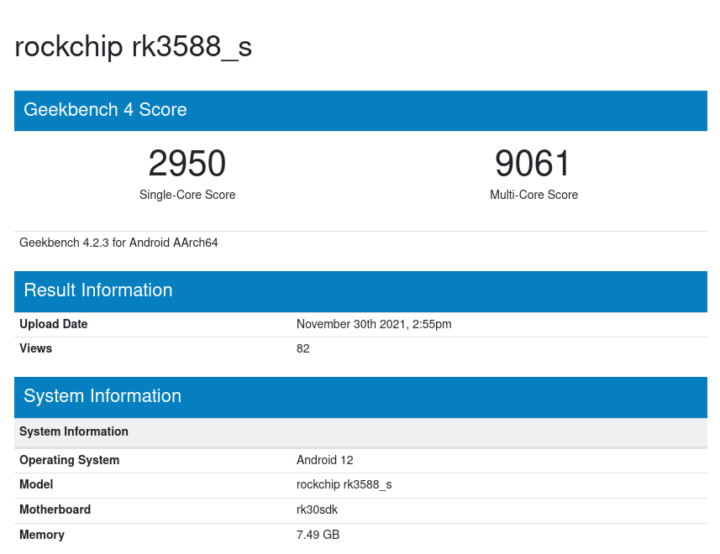 As a side note, the Identifier “ARM implementer 65 architecture 8 variant 4 part 3339 revision 0” is the same as for Dimensity 700 Cortex-A76/A55 processor, so that part looks right.
As a side note, the Identifier “ARM implementer 65 architecture 8 variant 4 part 3339 revision 0” is the same as for Dimensity 700 Cortex-A76/A55 processor, so that part looks right.
Bearing in mind that the new scores are higher, let’s see how the single-core score (2,950) and multi-core score (9,061) in GeekBench 4 compare to the ones for a system-based on a Rockchip RK3399 processor.
In the single-core benchmark, the Rockchip RK3588 Cortex-A76/A55 processor is 2.28 times faster than RK3399, and 2.8 times faster in the multi-core benchmark. Arm did announce a 2x performance uplift between Cortex-A73 and Cortex-A76 in terms of peak single-thread performance. I first tried to estimate RK3588’s Cortex-A76 CPU frequency, assuming 1.8 GHz for the Cortex-A72 on RK3399, 4.7 DMIPS/MHz for Cortex-A72, but I could not find data for the DMIPS/MHz for the Cortex-A76 core. But instead, we know the single-thread score for the Dimensity 700’s Cortex-A76 core @ 2.2 GHz is about 2.700 points. That would mean Rockchip RK3588’s Cortex-A76 cores are clocked at 2.4 GHz in that benchmark instead of 2.6 GHz for the latest benchmarks from Rockchip, while the Cortex-A55 cores are running at 1.8 GHz as reported by GeekBench 4.
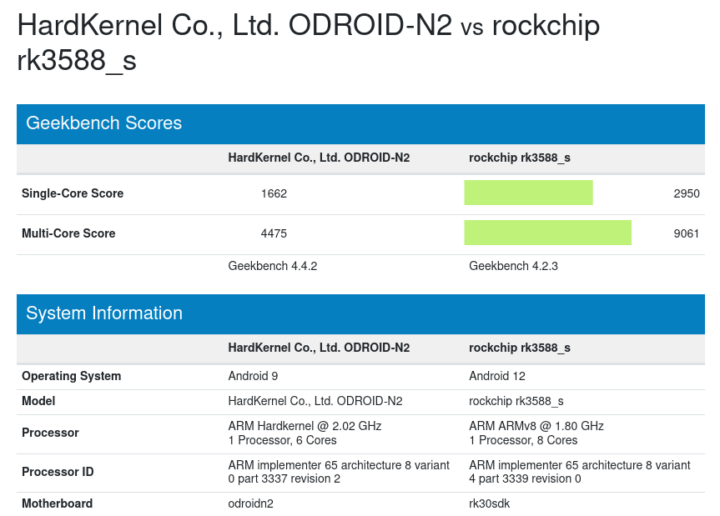 Since 2.4 GHz is also the frequency of the Amlogic S922X Rev C processor in ODROID-N2+ when overclocked, let’s do a little comparison here too. The Rockchip RK3588 is about twice as fast as ODROID-N2+ in both single-core and multi-core GeekBench v4 benchmarks. So even, if Rockchip RK3588 is coming late, it looks really promising even for 2022, provided the price is right.
Since 2.4 GHz is also the frequency of the Amlogic S922X Rev C processor in ODROID-N2+ when overclocked, let’s do a little comparison here too. The Rockchip RK3588 is about twice as fast as ODROID-N2+ in both single-core and multi-core GeekBench v4 benchmarks. So even, if Rockchip RK3588 is coming late, it looks really promising even for 2022, provided the price is right.
Some Geekbench v5 results are now available too, but Rockchip did not use those in their chart.
[Update: Antutu 9.2 benchmark on RK3588 evaluation board.
]
Thanks to Markon for the tip.
Updated: This post was initially published on December 1, 2021 with Geekbench4 results leaked online, and updated on December 16, 2021 with Rockchip providing updated GeekBench4 results as well as GFXBench and Antutu 9.2 benchmarks

Jean-Luc started CNX Software in 2010 as a part-time endeavor, before quitting his job as a software engineering manager, and starting to write daily news, and reviews full time later in 2011.
Support CNX Software! Donate via cryptocurrencies, become a Patron on Patreon, or purchase goods on Amazon or Aliexpress


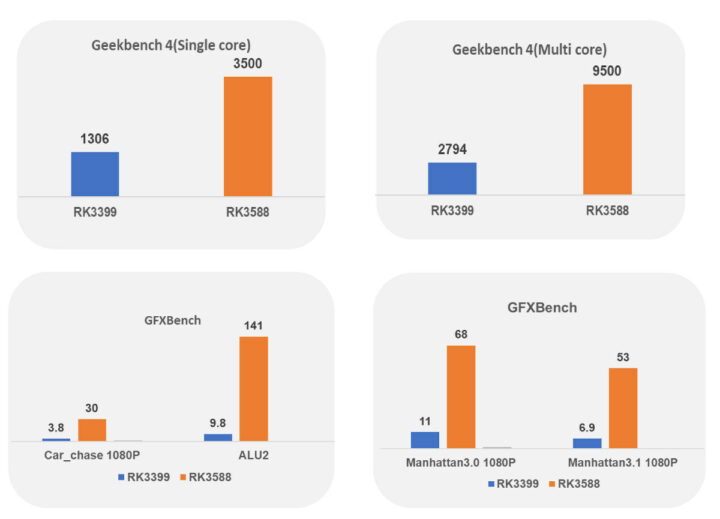
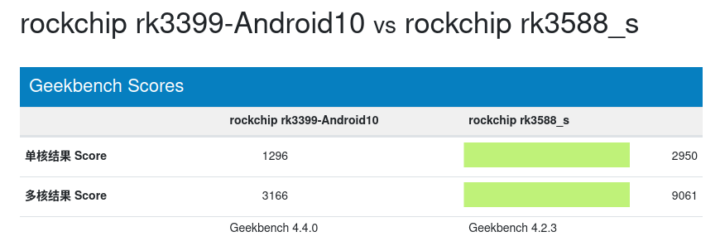
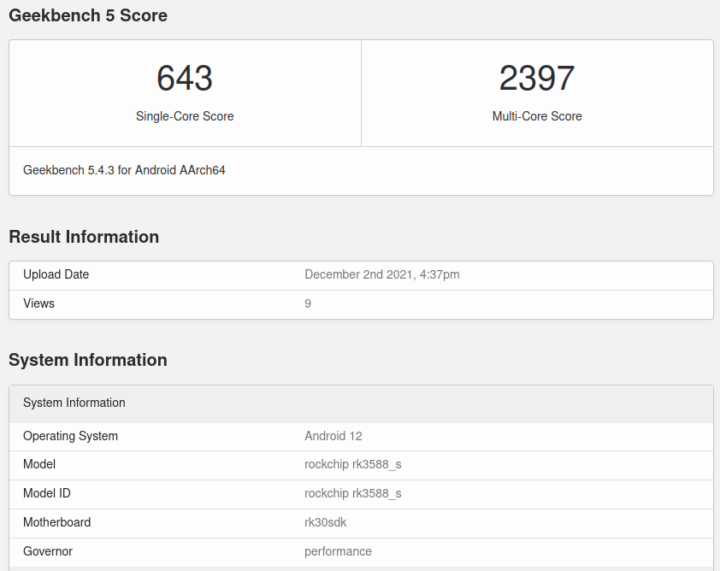
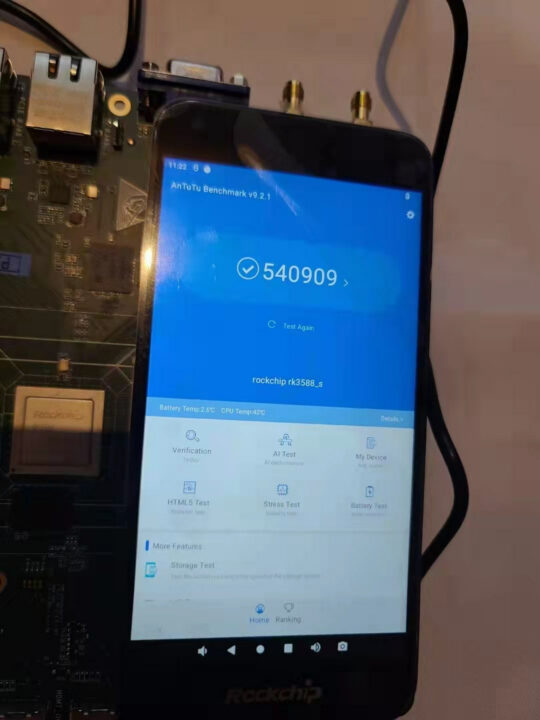


I think you meant to use RK3399 somewhere in there.
what about av1
RK3588 has been listed on the Wikipedia article for AV1 for months, maybe over a year.
It should support at least 4K60 with HDR, and possibly 8K.
H.265/VP9: 8K@60fps
H.264: 8K@30fps
AV1:4K@60fps
rock5 coming soon.
Hello Tom
Are Radxa going to make any more Radxa Zero boards ? Supply seems very limited .
More Radxa Zero shipping two weeks later.
Thanks Tom 😀
Finally.
So the vapor would start to dissipate ?
Looking at the comparison with the N2+ I suspect the CPU runs at 2.2 GHz. The AES performance test ought to be entirely dependent on the frequency, and the 8.2% faster would give 2.2 GHz there. Note that in the past the rockchip clk driver used to be limited to 2.1 GHz and would overflow to a negative value when trying to set it to 2.2 GHz. So it would indicate that this was finally fixed. Some tests like LLVM are almost twice as fast, this could indicate a serious boost, including in RAM performance, which appears more than twice as fast.
I saw other ODROID-N2 scores at about 13xx points for single-core performance, and I selected the highest score I could find, so I assumed this was 2.4 GHz.
I understand but in fact they compared it with N2 and it’s written “ARM Hardkernel @ 2.02 GHz 1 Processor, 6 Cores” so that’s clearly at 2.016. And it’s indeed an N2, not N2+. It makes sense to use this board for a comparison as it’s one of the rare ones with 4 high frequency big cores and with some small cores. Using N2 instead of N2+ inflates the difference though 🙂
The vapor should disapear not long from now, according to hipboi it should be on on 16th december https://forum.radxa.com/t/why-this-is-not-named-as-rock-pi-5/7912/6 – well, we will see, as in 2019 RK3588 was just around the corner.
Additionally it should made quite good desktop expirience, it’s almos competitive to some fx83xx chips in geekbench4 scores – i’m using fx right now and it’s still not so bad expirience in 2021 😀
Interesting, thanks for the link. Let’s see in two weeks when Tom presents his new product here 🙂
Think 8 years ago’s i7 laptops. That’s the performance you can expect, ie the 4700HQ.
At launch, Anandtech compared Huawei’s flagship A76 variant to an i5-5200u and started theorising that ARM would overtake x86 in a few years.
This doesn’t quite have the same performance as the Huawei part, but it’s close, and of course it has 4x the cores of the 5200u, so I think the 4700HQ is the better comparison point.
I have a 2nd gen i7 laptop that would still blow the RK3588 out of the water in most performance metrics.
What really blows any ARM out is software support. ARM = crap, x86 = perfect
Unless there isn’t an alliance of several companies for releasing a serious Linux distribution in collaboration with most of sbc makers in order to create a polished OS with drivers of everything up to date with quality on par with any device that is released for x86 platform, we won’t get anything decent ever. Everything sold will be steam, and will be used only for a limited of specific purposes, never for general use, so it will never replace any PC regardless of its age. Sad, but true.
Funny. It’s so late, the benchmark is on a version of Geekbench that’s several years old.
Geekbench 4 is not only old but the way ‘combined scores’ were calculated back then was fundamentally flawed especially when looking at the multi-threaded results. By looking at the individual tests at least conclusions wrt comparisons to other SoCs/CPUs can be drawn…
Yes, only the individual ones are interesting there.
I’ve just added Geekbench 5 results to the post.
“It’s to late, it’s vaporware”.. I wonder, for cheap arm linux devices, what we have TODAY? Rpi is out of discussion, being 28-40nm, N2+ have some decent HP but it’s not even close on power, ram bandwidth and I/O to.. not even compared to RK3399.
I detected a lot of rpi fanboys, also odroid fanboys a bit alarmed with RK3588 being a real thing. Most probably N3 will be based on RK3588, so you can stop using a tv box like the N2 as an sbc and acquire real desktop class sbcs like rockchips provide.
Inside X11 my RK3399s still outperform my N2 on mostly any game I’ve tried with panfrost, and that’s due RK3399 being 64 bit ram bus instead of 32. And while N2+ is a powerhouse on cpu, his I/O is pathetic and unreliable to say at least.
RK3588 will not be perfect, but far better than what we have now.
The charts included in this article show scores for both RK3399 and N2+. The scores are higher for N2+ than RK3399. Based on my personal use, the N2+ is also faster than RK3399 at everything I use it for.
So you didn’t test x11 gl performance neither I/O
The issue you are experiencing is with Panfrost. It is due to the maturity level of the open source driver and not related to hardware or I/O. You can expect similar issue with RK3588. Note that RK3399 uses the obsolete “midgard” GPU.
On single-thread, a *properly tuned* RK3399 should be faster than an N2 but less commonly compared to an N2+ at 2.4GHz. However on multi-thread the RK3399 suffers from two things:
Overall for the use cases I’ve measured to date (build times), the N2 is already quite faster than RK3399 (various boards), and the N2+ is significantly faster. But the A72 and A73 are really different, it’s hard to compare them as there can be two-fold ratios in performance in one direction or the other depending on the workloads.
You are only measuring cpu power. What about the I/O, even plugging more than one hard drive on the n2 is an invitation for troubles, not even talking about speeds!
What about gl performance on X11? Not that great, wayland is the future, not the present.
I operate a N2+ 24/7 since release with dual drives attached via USB. I have not encountered any issues that were not common to all SBCs (including RK3399).
Well, they are reports regarding how bad is the usb interfaces all around the forums, and they are specific odroid n2 ones.
So, it’s not only my problem. And for reliability, each usb 3.0 interface on rk3399s are real independent ones , not even taking in count the 4x pci 2.0 lanes that make your N2 family to go far away from contest.
Rockchip is clearly more oriented towards I/O in general than amlogic or others, I’m not denying that. For example RK3399 provides PCIe that S922X doesn’t provide. I haven’t met USB issues at all on the N2+, that doesn’t mean there aren’t, it could be that they were fixed between N2 and N2+ or that I just never met them.
I use RK3399 on the rockpro64 at 2.21/1.8 with no thermal problems whatsoever, but… it’s not efficient at all hahaha
Lucky to be able to use it that fast. I have 7 RK3399 boards. Some of them used to support 2.1/1.8 but do not anymore and are more like 2.1/1.6 or 2.1/1.7. Others are limited to 2.0/1.6. The thermal issues I’m talking about are that the chips gets hot very quickly even with a large heatsink and starts to throttle. At this point it’s useless to have a high frequency chip if it limits itself to 1.5G or so. I even modified the DTS on my devices to move the critical temperature far upper. Usually the boards start to throttle when getting close do 95°C. After a long testing I changed mine to 113°C while the critical temp is 115. This allows to avoid throttling. But one could say that it’s not the most trivial approach to reach high performance. Conversely, I received my N2+, changed the max frequency to 2.4, booted it, tested for a long time, and nothing happened, no overheating, no crash and constant performance all over the test. I can’t deny it’s way more stable. For sure I don’t have PCIe there. But the board incontestably delivers much higher performance for my use cases with no hassle with heat management. It’s not a matter of which one is better, it’s just that it’s two generations younger and that starts to count a lot!
Ohh, I am not denying the cpu power of S922X, it’s just that cpu power alone doesnt make a desktop capable board, you need the I/O, and also you need the 64 bit ram bus to have a pleasant gpu performance, something that N2 only have on wayland DEs, but whenever an opengl app run on xwayland … it sucks.
It’s not something that I am claiming… panfrost devs affirmed.. RK3399 surpass S922X gpu performance on X11 quite largely. And we are talking about a very old gpu.
My experiences on N2 on mainline were horrible ones, I am planning to sell it soon. But N3 will be a big leap on desktop, I am 99% sure it will be RK3588 based.
Maybe, but we possibly have different use cases for desktop. The only think I need for a desktop is a frame buffer that can scroll fast enough in a block so that commands run in xterm are not sluggish. I have no use at all for the GPU stuff and such things. The way I choose the CPU for a desktop is by having one with integrated VGA and the least possible GPU capability to be sure that the TDP is mostly dedicated to the CPU and not to the rest I have no use for. And I value a totally fanless desktop way more than a noisy one that can run whatever animated game. Just different use cases.
You can also delid the rk3399cpu, and replace ihs with copper shim adding liquid metal between, but its probably kinda overkill and additionally it’s tricky to ad proper copper shim to fit gap between cpuand heatsink (at least on nanopi m4)
Don’t get me wrong, I am not a rockchip fanboy neither, they are just the less worse maker.
If you have something better for the price, then your criticism would be justified.
The RK3399 also took a silly amount of time to arrive after it’s initial announcement, but that was slightly different. They sold the OP1 variant first and it took a long time for consumer RK3399 developer boards to become something other than a paper dream. Hopefully it won’t be a further 2-3 years before the 3588 hits consumer developer boards.
It probably will be ~2 years before any board start to appear.
Between showing up on geekbench and official release+sampling can take months to a year.
Another months to a year to design and release product based on it.
Probably will ship with android first.
Then another few months for community to make stable linux, and for the board to viable for regular non-developer consumer.
Things are changing now. RK3588 runs 5.10 kernel, which is not far from mainline. Let’s see what will reveal on the RK Developer Conference(RKDC) on 16th, Dec.
Tom, I really hope that your board will be easy to install (i.e. boot from SD then install to eMMC) and will not require the awfully broken series of rkflashtool that plague most RK-based SBCs. Because quite frankly, their proprietary flash image format is rockchip’s worst ennemy. I don’t count the number of almost dead RK boards in my collection that I gave up trying to use because you never have the right image to flash on them and can’t easily manipulate the partitions.
rkflashtool? That is from… 2013?
We don’t use it any more, we just use eMMC module and eMMC reader, write it like SD card on PC with etcher or similar tools and boot.
Yeah I mean all the awfully bogus flashing tools that are usually asked to use by various support teams when you brick a board… None of them works at all. Even the windows ones when run in a VM. It’s great that you’re using the eMMC reader instead, at least it’s trivial to fix issues. I have the same with my NanoPI-M4 and Neo4 and never faced a problem with this boards thanks to this.
Rock 5 still using eMMC? nvme or ssd M.2 please. Oh, and use LPDDR5 too if you can. Then it will have many use cases. Like maybe, there’s cheap VPS using Rock 5 in the future (nvme + DDR5 (ecc) + good enough CPU). Let my dream come true 🙂
NVME will require PCIe lanes that will not be usable for anything else. It’s fine to have it as an option, but not to sacrifice PCIe for storage when most users only want to store an OS on something more durable and faster than an SD card.
I agree. Basically, I have no problem with eMMC. But it’s pricey and uncommon. Hard to find. On the other hand, M.2 NVMe or SSD is cheaper, faster, more durable and easy to find.
Good to hear. RK3588 is pretty much on par with the 9W Elkhart Lake platform, maybe even slightly faster, but of course lacking Thunderbolt 3 and some other goodies. As such, it’s finally an affordable ARM developer platform that isn’t so slow it compels its users to cross-compiling on cheap x86 systems, which then directs that talent elsewhere. So this will be a transformative experience for the ARM ecosystem if it gets to market in a timely fashion.
In order to evaluate real progress, comparison with the Tegra X1 in the Shield would be more useful to see how far Rockchip has come since 2015.
1278 single core. 3747 multi.
looks promising for 2022? It doesn’t even look promising for 2020.
It’s several generations behind the current ARM cores, and it’s been delayed
for so long that it’s not even relevant anymore.
Well with some micro benchmarks this SoC achieves at least half the performance of some decent but already slightly outdated 8 core ARM designs…
e.g. Single-Core Score first results compared at 3.19GHz are theoretical ~1135 for RK3588 and ~1717 for M1 (or 643/~968 at 1.8GHz, armv8, 66%)?
This is still a big advance for Rockchip and wondering, if there will be additional information about why RK3588 was that later than RK356x products (resources, marketing, technical difficulties, cost ?)
Considering Meditek Dimensity 9000, Qualcomm Snapdragon 8cx Gen 3, Apple M1/M2 and Rockchip 3588 it is impressive what progress all companies show.
(reasons?: ‘AI’ benchmarks were ~27-31% compared to M1 and compared to cpu core results at ~30-50% for single core results)
> Single-Core Score first results compared at 3.19GHz are theoretical ~1135 for RK3588
What? Enjoying combined Geekbench scores is rather silly (especially for a new platform where just 1 result is leaked) but if we would do it’s this:
The A76 in RK3588 might then score something around 850-860 at 3.2 GHz (or slightly higher if they’re currently clocked at 2.2 GHz). Other A76 (as in the MT6785 or MT6833 both @ 2.0 GHz for example) come in at ~500 – ~550.
interesting comparison, but also shows difficulties comparing different architectural SoC structures (not for usability and performance on consumer side consideration, but being measure for hardware quality levels between companies?): How much down-clocking core speed of Apple Firestorm until score gets to 643?
Who cares? Comparing Geekbench scores is (and maybe makes) silly. Their methodology hides most relevant things and they even fail to report basics such as clockspeeds properly.
How stupid is it to a) trust in ‘clockspeeds’ they find somewhere below /sys on Linux/Android and b) to consistently report the wrong ones (running the test on a big core while showing the clock of a little, reporting ‘base clock’ while running the test at a boost clock much higher on x86 and so on).
We even don’t know if a sbc board core is benchmarked at freezing outside temperatures or consumer equipment on the beach?
Who cares?
Data for one Geekbench score shows more details compared to data on comparison for two Geekbench scores (was missing Cluster 1 and Cluster 2), so ‘Base Frequency’ was input to assumptions (and could have been new cluster arrangement with dynamIQ on 2021 i.property).
Ofc, I Would also like radxa, hardkernel, orange pi, khadas etc. to have sbc with 16x Cortex-X1@3GHz, 1xCD Disk of L3 Cache, plenty of IO (pcie 5.0 mostly) etc.
But unfortunately it will not happen anytime soon, and even if we get SD888 or top tier Exynos on some boards they will probably be pretty IO limited and expensive.
Apple is also not an option, as they will not sell it’s SoC to anyone and current platforms of theirs is really not flexible.
Yet we also need to look at it from a bright side – maybe it would be cheap compared to alternatives, it will offer flexible IO, it will be still 2 x performance (here (vs Raspberry Pi CM4), here (vs VIM3), here (vs RK3399), here (vs ODROID-H2) and even almost here (AMD FX8300)) of any current platform and probably it will come in variety of flavors for anyone to choose from.
Additionally speaking of outdated architectures it’s still usable as a desktop 10 years later, yet it’s no more performant in still relevant single thread ;).
from consumer side (16cores reference platforms for entry, advanced, expert levels?): Value and preferences between one most capable multi-core computing platform (https://browser.geekbench.com/v5/cpu/compare/11411521?baseline=11371316) or several connected mid-range performance computing boards?
> I Would also like radxa, hardkernel, orange pi, khadas etc. to have sbc with 16x Cortex-X1@3GHz, 1xCD Disk of L3 Cache, plenty of IO (pcie 5.0 mostly) etc.
Me not since what’s the point of SBC if they’re neither inexpensive nor energy efficient?
Agreed! If I want to use these SBC for desktop and have to cough up, say, $135 for Odroid N2 (shipping and tax), I’d rather get used x86 mini-pc like NUC or the like (prodesk, thinkcentre, optiplex) that usually available at $165 here with 4GB RAM and 500GB HDD. i3 6100T undervolted is quite frugal. Can upgrade memory, use nvme.
what you propose exists.one is brand new and is the com-hpc platform for instance with an ampere altra another offer is the solidrun honeycomb. the latter has been available for a few years so instead of x1’s you get a72 and obviously not pcie5 but pcie3. but other than that it’s totally cool.
these are also priced the same as a ryzen 5950 or epyc milan 64-core.
The integer performance of the CA-76 is about the same as the Intel Skylake cores at the same frequency.
RK3588 vs i3 6100T: https://browser.geekbench.com/v5/cpu/compare/11304192?baseline=11371316
Looks good, especially on multicore perf.
> RK3588 vs i3 6100T … Looks good, especially on multicore perf.
Looks ‘as expected’ when comparing a dual core with an octa core design?
For me, yes, it’s ‘as expected’. IMHO, good enough for most people if they ever use this for desktop. Usually the bottleneck is with the storage (and OS).
Anyone here could guess what’s the price difference between comparable Cortex-A76 and Cortex-A77 cores, not licensing, but production cost?
Snapdragon 865 (Q4 2019, ~7nm, 1xPrimeCore A77 based 2.84GHz, 3xA77 2.42GHz, 4xA55 1.8Ghz, Adreno 650, ~10.3 billion transistors) processor $US~52-84. (SD 875 $US~130?)
Exynos 9610 (Q4 2018, ~10nm, 3 billion transistors) seen for ~$15 per unit.
Snapdragon 450 (2018, ~14nm, 2 billion transistors) less than $8.
Apple M1: $45~$64, 16 billion transistors.
Rockchip rk3568 (2020, ~22nm) ~$22 (~1000pcs)
Comparing these two numbers makes not that much sense.
tonny refers to what Apple might pay TSMC for their own chips while the RK3568 numbers are about what Rockchip’s customers need to pay (license fees and R&D efforts included). Do you know how much the chip foundry charges RK for the wafers?
seems these are all customer prices for phones or SBCs manufacturer market (and SD975 a pre production assumption) and their bill of materials (what fits for a current smartphone having ~$71 for application processor (including modem) for a Exynos 9820 listed, while for that Galaxy S10 display is $86, camera ~$56 and 8GB memory sums to $50. From materials to consumer price (including margin) there’s most times a doubling in numbers, with ~$300 salary a month for Foxconn workers (‘awful’ working conditions, Taiwanese companies in China for low price, but most smartphones >50% profit seen from sales price). New market trends like folding display smartphones are from US$ 999 – 1999.)
Apple application processors A12/A13 (incl. modem) are ~$60-70 (foundry sale might be ~>$30-35 (w/o modem) ), while a Galaxy S20 ultra (Exynos 990) can be seen in parts of $81/$26 application and baseband proc, cameras $107, display $67, ram (8GB) $44, nand (128-512GB?) $23.
A rough guess for foundry cost to customers on mm² for TSMC node could be a 22nm (rk3568, 361mm², ~5 billion Tr?) $0.07 (incl. cost for waste because of defective elements on a wafer), or $0.10-0.16 for more costlier 10nm-7nm nodes, while Rockchip seems more reliant on GlobalFoundries so far, AFAIK
(with big degrees of freedom from influences from public sources)
The gauntlet is thrown down.
Over to AMlogic with their S908X to see what that can do.
Yes, YES, YESSS, this is even a bit better than I anticipated. And that GPU, once Mesa/Lima works on it, this might displace my current edge GPGPU setup.